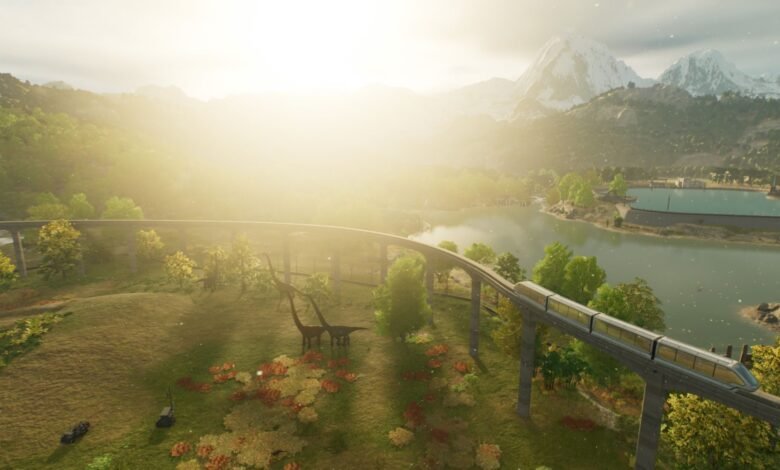Jurassic World Evolution 3 Review: Dino Brilliance Marred by Busywork

▼ Summary
– Jurassic World Evolution 3 is a park management simulation game where players can breed, genetically modify, and manage over 70 dinosaur species while building custom scenery.
– The game features an innovative campaign with interconnected global parks and dynamic objectives that unlock as your reputation grows.
– Players can engage in activities like DNA modification to alter dinosaur traits and create hybrid species, adding depth to the management experience.
– Some mechanics, such as balancing conflicting dinosaur habitat needs and managing comfort levels, can become repetitive and detract from the core gameplay.
– While the game offers extensive creative tools and detailed dinosaur models, it lacks the flexible enclosure design and creature simulation found in similar titles like Planet Zoo.
Jurassic World Evolution 3 delivers a deeply engaging park management experience that lets players resurrect, breed, and genetically enhance over 70 dinosaur species while constructing custom habitats from the ground up. This latest installment in the series introduces a more robust management loop and an inventive campaign structure, though it sometimes bogs players down with repetitive tasks that can detract from the overall creative freedom.
The game stands out as the most creatively ambitious entry yet, allowing players to design their own buildings and scenery using an extensive library of parts. From rock formations and fossils to structural elements like gantries and girders, the tools available enable detailed blueprint creation. The addition of part-scaling mechanics and more intelligent path-placing systems makes designing parks smoother than ever, while fully animated plants that react to weather conditions add a layer of immersion.
At its core, Jurassic World Evolution 3 revolves around a compelling management cycle. Players hire scientists to lead fossil-hunting expeditions, extract dinosaur DNA, and synthesize species ranging from gentle herbivores to ferocious carnivores. Once incubated, dinosaurs can be released into carefully crafted exhibits, but maintaining their well-being involves balancing environmental needs like foliage, water sources, and terrain types. This becomes especially challenging when housing multiple species together, as their requirements, and those of juveniles versus adults, often conflict, turning habitat design into a complex puzzle.
Beyond basic care, players must also address the commercial side of park operations. Constructing viewing galleries, organizing guided tours, and placing amenities help generate revenue while keeping guests entertained, and safe. Carnivore breakouts add thrilling urgency, requiring quick intervention with tranquilizer darts to prevent prehistoric predators from turning visitors into snacks.
The campaign mode offers a refreshing take on the franchise narrative. As the head of the Dinosaur Integration Network (DIN), players work to help dinosaurs coexist with humans across multiple global locations. Missions unlock progressively as your reputation grows, creating a dynamic sense of running an interconnected international sanctuary network rather than isolated parks. Jeff Goldblum’s return as Ian Malcolm adds charismatic flair, even if his dialogue often echoes familiar themes from the films.
For those seeking structured challenges, the Challenge Mode presents scenarios like containing aggressive carnivores with limited resources or managing species without genetic modifications. These focused tests provide satisfying ways to hone management strategies outside the main campaign.
Where Jurassic World Evolution 3 truly excels is in its creature presentation. While overhead park views may seem visually standard, the dinosaurs themselves are stunningly detailed. Ray-traced lighting enhances textures and shadows, bringing these prehistoric beasts to life during close encounters. Watching sauropods wade through sun-dappled waterways or observing raptors in dense foliage provides moments of genuine awe.
Players can immerse themselves further by taking control of park vehicles, helicopters for aerial surveys, ranger jeeps for medical deliveries, and capture teams for containing escaped dinosaurs. First-person perspectives from guest viewpoints and ride cameras deepen the sense of being inside a living, breathing park.
However, the game’s emphasis on management sometimes leads to friction. Juggling dinosaur comfort levels, especially in mixed-species enclosures, can feel like tedious busywork. Adjusting environmental elements to satisfy one species often displeases another, and tour path construction frequently resets painstakingly placed foliage. These mechanics force players into reactive cycles of problem-solving that interrupt more enjoyable activities like genetic experimentation or custom scenery design.
Despite these frustrations, Jurassic World Evolution 3 offers plenty for simulation enthusiasts. The expanded creative tools, intricate management systems, and cinematic dinosaur interactions create a compelling package. Accessibility features like colorblind-friendly UI options, customizable subtitles, and effect toggles ensure a more inclusive experience across player needs.
Available on PS5, Xbox Series X/S, and PC, the game performs smoothly on capable hardware. Testing on systems like the Acer Predator Helios 300 with an RTX 3080 GPU maintained consistent frame rates, though the visual impact is most pronounced during ground-level dinosaur encounters rather than managerial overviews.
Jurassic World Evolution 3 represents a significant evolution for the series, blending deep management mechanics with enhanced creative freedom. While its tendency toward micromanagement may frustrate players seeking a purely relaxed building experience, those who enjoy juggling complex systems alongside dinosaur wrangling will find plenty to love. With its global campaign, genetic customization, and beautifully realized creatures, it sets a new standard for prehistoric park simulations, even if it occasionally gets tangled in its own ambitious systems.
(Source: techradar)





